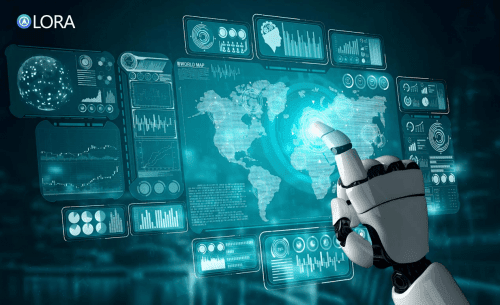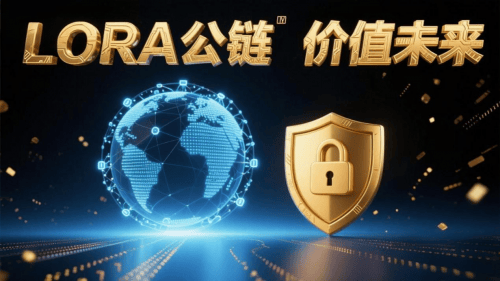In the wave of global technological change, a brand new paradigm is accelerating to take shape—AI (artificial intelligence) + IoT (internet of things) + Web3. The deep integration of the three is redefining the value structure of data, the trust mechanism of networks, and the collaborative logic between devices. It is no longer just a point of technological innovation but a comprehensive reconstruction of the future internet infrastructure.
It is against this backdrop that the LORA public chain has emerged. It is not a dedicated solution for a specific vertical scenario, nor merely another generation of public chains focused on performance optimization, but a globally oriented underlying intelligent operating system dedicated to providing trustworthy access and efficient collaboration for the billions of smart devices, edge nodes, and autonomous networks of the future.

The grand vision of three-way integration: AI × IoT × Web3, reshaping the value internet.
In the post-mobile internet era, AI and IoT are driving the world towards 'ubiquitous perception, ubiquitous interconnectivity, and ubiquitous intelligence'; while Web3 offers another dimension of possibilities—ensuring data ownership, traceable value, and trustworthy collaboration.
AI: Breaking decision-making bottlenecks, achieving 'human-like cognition + on-chain execution'.
IoT: Bringing real-world devices and data onto the chain, bridging the physical and digital spaces.
Web3: Building collaborative logic and economic models that do not require centralized trust.
However, in practical implementation, there are still gaps in the development of the three systems. The mission of LORA is to bridge the connection structure of these three major systems, creating a usable, scalable, and sustainable collaborative platform for developers, device providers, data providers, and end users.

The technical framework of LORA: Comprehensive integration from underlying consensus to upper-level intelligence.
As a new generation of general-purpose infrastructure, LORA has built a blockchain underlying architecture that is friendly to AI and IoT scenarios, with its technological innovation mainly reflected in the following dimensions:
1. Native AI intelligent modules.
LORA not only supports the on-chain inference results of AI but also natively supports the deployment of AI Agents and the parsing of on-chain execution logic at the virtual machine level, allowing developers to invoke on-chain intelligent models for dynamic execution and trace AI behavior through on-chain behavior trees, enhancing governance transparency and result verifiability.
2. Data link architecture for IoT
Through modular data collection gateways and edge node engines, LORA can achieve multi-protocol compatible access for various industrial sensors and consumer-grade smart devices, encrypting, fragmenting, and mapping raw data onto the chain to form 'data assets' with value circulation.
3. High-performance Layer-1 design.
Using lightweight consensus and multithreaded execution engines, supporting high-concurrency device data uploads and real-time contract responses, meeting the technical requirements for massive heterogeneous devices in IoT to be online simultaneously, while providing a real-time environment for AI model invocation and result verification.
4. Multi-role co-governance mechanism.
LORA not only serves developers but also designs incentive and governance mechanisms for various roles such as 'data providers', 'intelligent model providers', and 'device operators', laying an economic foundation for forming a complex and self-organizing ecological network.
Building a global intelligent ecosystem: LORA's strategic map.
From a strategic perspective, LORA does not attempt to enter the market from a single scenario but instead aggregates global forces with a platform mindset.
Developer side: Providing a full-stack SDK compatible with EVM, supporting rapid deployment of multi-language and multi-protocol applications, lowering the development threshold for AI + IoT Dapps.
Device side: Collaborating with hardware manufacturers and edge computing platforms to embed linking capabilities natively into devices and nodes, forming a decentralized network where 'edge is the node'.
Data side: Attracting high-quality data sources to access the chain through data ownership and value incentive mechanisms, serving AI training and decision models.
Community governance side: Introducing a global node co-construction mechanism, from Southeast Asia to the Middle East, from Europe and America to Africa, LORA is accelerating the node deployment process in the global ecological map.
Application scenario map: From edge devices to smart cities.
LORA has a natural adaptability to various scenarios and will achieve breakthroughs in the following fields in the future:
Industrial IoT: Real-time on-chain device data, AI decision-driven warnings and collaborations, building smart factories.
Smart Cities: Environmental monitoring, traffic device linking, forming an on-chain intelligent scheduling system.
AI Content Market: On-chain publishing and invocation of AI models, enabling the tokenization mechanism of AI as a service.
Personal data network: Linking user devices and the circulation of privacy data ownership, achieving a monetization pathway for data.
In conclusion: LORA's vision is not just about technology, but also a part of the future global digital order.
As blockchain enters the 'post-DeFi era', technological infrastructure is once again becoming a competitive focus. The emergence of LORA brings different dimensions of thinking to the entire industry.
It's time to consider the system-level collaborative relationship between blockchain, AI, and IoT.
It is time to build the next generation of digital infrastructure that supports the operation of the physical world.
It's time to launch an intelligent value network based on global consensus.
LORA is not a follower of a particular trend but a long-term builder across technologies, industries, and eras. At the center of this convergence trend, LORA defines boundaries with technological architecture and expands them through ecological practices.